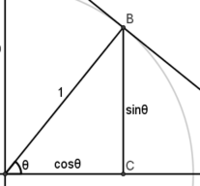I was talking to someone the other day who was telling me they never learnt SOHCAHTOA to solve right angled triangles problems at school. Instead they were introduced to the unit circle and were told the x coordinate was cos( theta) and the y coord was sin(theta).

And then every trig problem can be done through scaling ( i think?).
Is this approach familiar to anyone and what do they see as the benefits of this over SOHCAHTOA?
I guess i am saying what is the definition of these functions? Clearly there is consistency between the two ways of thinking. But i am curious why one approach might be used instead of the other.
I understand these ideas are typically taught at the age of 13.

And then every trig problem can be done through scaling ( i think?).
Is this approach familiar to anyone and what do they see as the benefits of this over SOHCAHTOA?
I guess i am saying what is the definition of these functions? Clearly there is consistency between the two ways of thinking. But i am curious why one approach might be used instead of the other.
I understand these ideas are typically taught at the age of 13.
